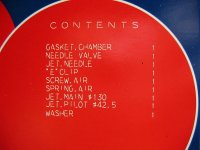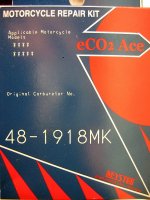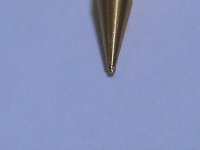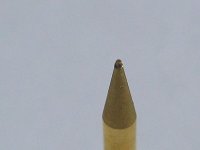Well, if you can turn the mix screw in all the way and it doesn't kill that right cylinder (it should), that would seem to indicate an overly rich condition, not lean. Closing the mix screw cuts off approximately 25% of the fuel/air mix flow coming from the pilot jet, and that's usually enough to stall that cylinder.
When I engage the cold start (press choke lever down), the right side runs much better...almost normal. Doesn't the choke
enrich the mix?
There's a few things that might cause the rich mix. Maybe a damaged mix screw tip or seat in the hole it screws into. Maybe you could compare the 2 mix screw tips, see if they look any different. Maybe swap them carb to carb and see if it makes any difference.
The screw tips, themselves, are fine. Remember, I've now gone through two sets of rebuild kits from two different vendors and, although not impossible, I think it's nearly so for two different screws from different vendors to cause the same problem, especially, since the problem's limited to one carb and both now have the same new internal components (i.e., jets, needles, seals, gaskets, etc.). The only deviations from the rebuild parts are: 1) I replaced the diaphragm in the carb on the
good (left) side (with a JBM diaphragm) because it didn't appear to be holding a good vacuum (even with the JBM, the piston drops in ~3~4 seconds with the oval port blocked (
carb on the bad side, with new (ebay-purchased) piston/diaphragm, drops in ~15 seconds)); and 2) per recommendation, I swapped-out the rebuild kit's "Y22" stamped needles (which are the same type of needle that's been in there for the past several years) for Mikuni 4JN19 needles in both carbs.
I'll check the current screw's tip again and I guess I can disassemble the right carb and re-clean all of its internal journals again, but, having done this already five or more times, my gut tells me the problem's elsewhere. But, as I'm outta options, I'll give it a try..
Too high of a fuel level in the bowl would make it run rich too. If you're using an aftermarket pilot jet, maybe it's size is off. Also, is it the proper type (BS30/96) for your carb set?
The floats're set to 24mm (OEM spec), measured from the base of the carb body (sans gasket) to the top of the float. The jets in both rebuild kits (42.5 and #130) were the same size as the ones that've been in there for the past several years and, according to the Yamaha Service Manual, they're correct.
Then there's also the possibility that the carb is just plain worn out, internal passageways have worn larger and are passing more fuel. It happens.
I considered that as well, but, because the bike was running fine until I didn't use it for four or five months, "wear" doesn't really make sense. My gut tells me that something's gotta be either gummed-up/blocked, corroded or leaking. Could months of non-use coupled with high humidity and heat cause one of the sets of points to've become oxidized, rusted or something like that that could cause the backfiring and rough idling?




